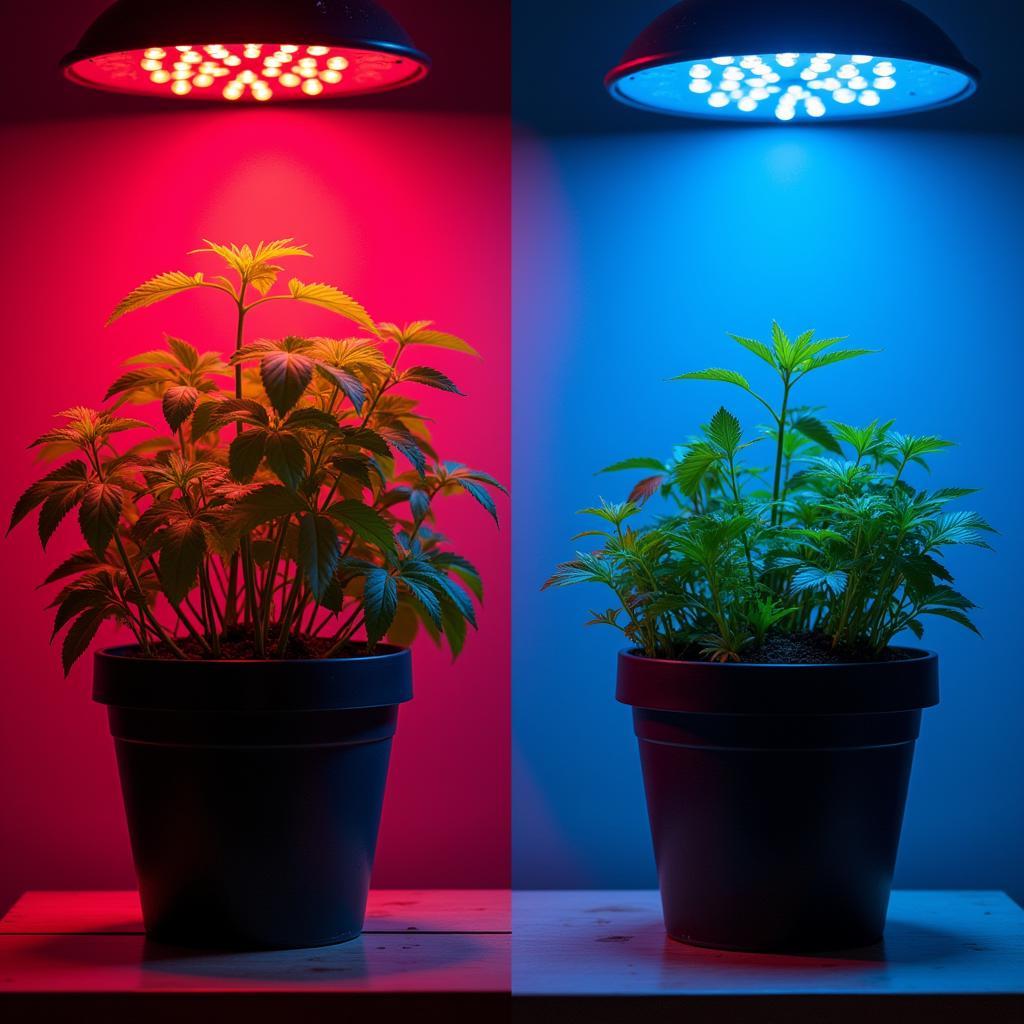As a color enthusiast and design specialist, I’m often asked about the impact of color on our daily lives. One area where color plays a crucial role is in the realm of plant growth. While we might find aesthetic pleasure in the vibrant green hues of our leafy companions, the color of light itself has a profound impact on their ability to thrive.
The Science of Light and Plant Growth
Plants, unlike humans, can absorb light energy and convert it into food through a process known as photosynthesis. This process is powered by a specific pigment in plants called chlorophyll, which absorbs light most effectively in the red and blue wavelengths of the light spectrum.
 The Spectrum of Light and Plant Growth
The Spectrum of Light and Plant Growth
Red Light: Fueling Growth and Flowering
Red light plays a crucial role in the photosynthesis process, specifically in the production of carbohydrates, which are essential for plant growth and development. Red light also influences phytochrome, a light-sensitive pigment in plants, prompting flowering and fruiting.
Blue Light: Essential for Leaf Development and Strong Stems
Blue light is vital for chlorophyll production, influencing the overall health, size, and shape of leaves. Additionally, blue light encourages strong stem development and can even help prevent plants from becoming leggy.
 Plants Growing Under Different Light Colors
Plants Growing Under Different Light Colors
The Role of Other Colors
While red and blue light are the powerhouses of plant growth, other colors in the light spectrum also contribute to their well-being:
- Green light: Although chlorophyll absorbs very little green light, reflecting it back, a small amount can penetrate deeper into the plant canopy, supporting the growth of lower leaves.
- Yellow and orange light: These colors play a more supplemental role in photosynthesis and can influence certain plant processes, but are generally less critical than red and blue light.
- Ultraviolet (UV) light: While excessive UV light can be harmful, small amounts can benefit some plant species by boosting their resistance to pests and diseases.
Choosing the Right Light for Your Plants
Understanding the role of light color in plant growth can help you make informed decisions when choosing artificial lighting for indoor gardening or supplemental lighting for your outdoor spaces.
Here are a few things to keep in mind:
- Full-spectrum grow lights: These lights mimic natural sunlight and are ideal for supporting all stages of plant growth, from seedling to harvest.
- Red and blue LED grow lights: These energy-efficient lights focus on the most crucial wavelengths for plant growth, making them a popular choice for indoor gardeners.
- Adjusting light color based on plant needs: You can adjust the color of your grow lights depending on the specific requirements of your plants. For example, increasing the amount of red light can promote flowering in plants like orchids and tomatoes.
The Impact of Light Color: Beyond the Basics
The influence of light color extends beyond the fundamentals of photosynthesis. It can affect a plant’s:
- Shape and Size: Plants exposed to different light colors may exhibit variations in height, leaf size, and overall compactness.
- Nutrient Uptake: The right light balance can enhance a plant’s ability to absorb and utilize essential nutrients.
- Flavor and Aroma: In some cases, specific light wavelengths can influence the development of compounds that contribute to a plant’s taste and smell.
Color Your World with Healthy, Thriving Plants
Just as choosing the right paint color can transform a room, understanding the nuances of light color can significantly impact the health and vitality of your plants. By harnessing the power of the light spectrum, you can cultivate a lush indoor oasis or a bountiful outdoor garden, bringing the joy of nature into your life.
Frequently Asked Questions
Can I use regular LED lights for plant growth?
While regular LED lights can provide some light for plants, they often lack the specific red and blue wavelengths essential for optimal growth. It’s best to opt for full-spectrum grow lights or LED lights specifically designed for plants.
How long should I keep my grow lights on each day?
Most plants require 12-16 hours of light per day for optimal growth. However, the specific duration may vary depending on the plant species and its growth stage.
Do plants need darkness?
Yes, plants need a period of darkness each day to perform essential processes like respiration. A typical light cycle for indoor plants is 12 hours of light followed by 12 hours of darkness.
Can too much light be harmful to plants?
Yes, excessive light intensity or duration can lead to a condition called light burn, which can damage plant tissues. It’s important to choose the appropriate light intensity for your plants and gradually acclimate them to changes in light exposure.
What are some signs that my plants are not getting enough light?
If your plants are not getting enough light, they may exhibit signs like leggy growth (stretching towards a light source), pale or yellowing leaves, and slow or stunted growth.
Do I need to fertilize my plants if I’m using grow lights?
Yes, even with grow lights, plants still need essential nutrients from soil or fertilizer.
Can I grow any plant under grow lights?
Yes, you can grow a wide variety of plants under grow lights, including vegetables, herbs, flowers, and even some fruit trees.
Need help choosing the best lighting for your green companions?
Contact us today! Phone: 0373298888, Email: [email protected], Address: 86 Cầu Giấy, Hà Nội. Our dedicated team is available 24/7 to assist you.
Explore more about the captivating world of color and its impact:
Let us help you create a vibrant and thriving space for your plants to flourish!

